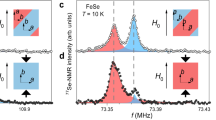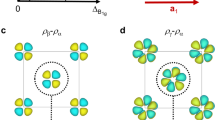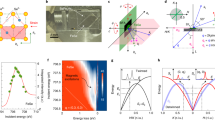Abstract
In common with other iron-based high-temperature superconductors, FeSe exhibits a transition to a ‘nematic’ phase below 90 K in which the crystal rotation symmetry is spontaneously broken. However, the absence of strong low-frequency magnetic fluctuations near or above the transition has been interpreted as implying the primacy of orbital ordering. In contrast, we establish that quantum fluctuations of spin-1 local moments with strongly frustrated exchange interactions can lead to a nematic quantum paramagnetic phase consistent with the observations in FeSe. We show that this phase is a fundamental expression of the existence of a Berry’s phase associated with the topological defects of a Néel antiferromagnet, in a manner analogous to that which gives rise to valence bond crystal order for spin-1/2 systems. We present an exactly solvable model realizing the nematic quantum paramagnetic phase, discuss its relation with the spin-1 J1–J2 model, and construct a field theory of the Landau-forbidden transition between the Néel state and this nematic quantum paramagnet.




Similar content being viewed by others
References
Anderson, P. W. The resonating valence bond state in La2CuO4 and superconductivity. Science 235, 1196–1198 (1987).
Figueirido, F. et al. Exact diagonalization of finite frustrated spin-1/2 Heisenberg models. Phys. Rev. B 41, 4619–4632 (1990).
Jiang, H.-C., Yao, H. & Balents, L. Spin liquid ground state of the spin-1/2 square J1–J2 Heisenberg model. Phys. Rev. B 86, 024424 (2012).
Gong, S.-S., Zhu, W., Sheng, D. N., Motrunich, O. I. & Fisher, M. P. A. Plaquette ordered phase and quantum phase diagram in the spin-1/2J1–J2 square Heisenberg model. Phys. Rev. Lett. 113, 027201 (2014).
Haldane, F. D. M. O(3) nonlinear σ model and the topological distinction between integer- and half-integer-spin antiferromagnets in two dimensions. Phys. Rev. Lett. 61, 1029–1032 (1988).
Read, N. & Sachdev, S. Valence-bond and spin-Peierls ground states of low-dimensional quantum antiferromagnets. Phys. Rev. Lett. 62, 1694–1697 (1989).
Qazilbash, M. M. et al. Electronic correlations in the iron pnictides. Nature Phys. 5, 674–650 (2009).
Si, Q., Abrahams, E., Dai, J. & Zhu, J.-X. Correlation effects in the iron pnictides. New J. Phys. 11, 045001 (2009).
Yin, Z. P., Haule, K. & Kotliar, G. Kinetic frustration and the nature of the magnetic and paramagnetic states in iron pnictides and iron chalcogenides. Nature Mater. 10, 932–935 (2011).
Gretarsson, H. et al. Revealing the dual nature of magnetism in iron pnictides and iron chalcogenides using x-ray emission spectroscopy. Phys. Rev. B 84, 100509 (2011).
Maletz, J. et al. Unusual band renormalization in the simplest iron-based superconductor FeSe1−x . Phys. Rev. B 89, 220506 (2014).
Nakayama, K. et al. Reconstruction of band structure induced by electronic nematicity in an FeSe superconductor. Phys. Rev. Lett. 113, 237001 (2014).
Watson, M. D. et al. Emergence of the nematic electronic state in FeSe. Phys. Rev. B 91, 155106 (2015).
Zhang, P. et al. Observation of two distinct d xz/d yz band splittings in FeSe. Phys. Rev. B 91, 214503 (2015).
Chu, J.-H., Kuo, H.-H., Analytis, J. G. & Fisher, I. R. Divergent nematic susceptibility in an iron arsenide superconductor. Science 337, 710–712 (2012).
Chandra, P., Coleman, P. & Larkin, A. Ising transition in frustrated Heisenberg models. Phys. Rev. Lett. 64, 88–91 (1990).
Fang, C., Yao, H., Tsai, W.-F., Hu, J. & Kivelson, S. A. Theory of electron nematic order in LaFeAsO. Phys. Rev. B 77, 224509 (2008).
Xu, C., Müller, M. & Sachdev, S. Ising and spin orders in the iron-based superconductors. Phys. Rev. B 78, 020501 (2008).
Baek, S.-H. et al. Orbital-driven nematicity in FeSe. Nature Mater. 14, 210–214 (2015).
Böhmer, A. E. et al. Origin of the tetragonal-to-orthorhombic (nematic) phase transition in FeSe: A combined thermodynamic and NMR study. Phys. Rev. Lett. 114, 027001 (2015).
Affleck, I., Kennedy, T., Lieb, E. H. & Tasaki, H. Rigorous results on valence-bond ground states in antiferromagnets. Phys. Rev. Lett. 59, 799–802 (1987).
Arovas, D. P., Auerbach, A. & Haldane, F. D. M. Extended Heisenberg models of antiferromagnetism: Analogies to the fractional quantum Hall effect. Phys. Rev. Lett. 60, 531–534 (1988).
Peschel, I. & Emery, V. Calculation of spin correlations in two-dimensional Ising systems from one-dimensional kinetic models. Z. Phys. B 43, 241–249 (1981).
Jiang, H. C. et al. Phase diagram of the frustrated spatially-anisotropic s = 1 antiferromagnet on a square lattice. Phys. Rev. B 79, 174409 (2009).
Senthil, T., Vishwanath, A., Balents, L., Sachdev, S. & Fisher, M. P. A. Deconfined quantum critical points. Science 303, 1490–1494 (2004).
Abanov, A. & Wiegmann, P. Theta-terms in nonlinear sigma-models. Nucl. Phys. B 570, 685–698 (2000).
Xu, C. & Ludwig, A. W. W. Nonperturbative effects of a topological theta term on principal chiral nonlinear sigma models in 2 + 1 dimensions. Phys. Rev. Lett. 110, 200405 (2013).
Nie, L., Tarjus, G. & Kivelson, S. A. Quenched disorder and vestigial nematicity in the pseudogap regime of the cuprates. Proc. Natl Acad. Sci. USA 111, 7980–7985 (2014).
Kasahara, S. et al. Field-induced superconducting phase of FeSe in the BCS-BEC cross-over. Proc. Natl Acad. Sci. USA 111, 16309–16313 (2014).
Terashima, T. et al. Anomalous Fermi surface in FeSe seen by Shubnikov–de Haas oscillation measurements. Phys. Rev. B 90, 144517 (2014).
Wang, Q. et al. Strong interplay between stripe spin fluctuations, nematicity and superconductivity in FeSe. Preprint at http://arXiv.org/pdf/1502.07544 (2015)
Glarum, S. H., Geschwind, S., Lee, K. M., Kaplan, M. L. & Michel, J. Observation of fractional spin S = 1/2 on open ends of S = 1 linear antiferromagnetic chains: Nonmagnetic doping. Phys. Rev. Lett. 67, 1614–1617 (1991).
Glasbrenner, J. K., Mazin, I. I., Jeschke, H. O., Hirschfeld, P. J. & Valent, R. Effect of magnetic frustration on nematicity and superconductivity in Fe chalcogenides. http://dx.doi.org/10.1038/nphys3434 (2015)
Rong, Y. & Si, Q. Antiferroquadrupolar and Ising-nematic orders of a frustrated bilinear-biquadratic Heisenberg model and implications for the magnetism of FeSe. Preprint at http://arXiv.org/pdf/1501.05926 (2015)
Chubukov, A. V., Fernandes, R. M. & Schmalian, J. Origin of nematic order in FeSe. Phys. Rev. B 91, 201105 (2015).
Acknowledgements
We thank H. Jiang and T. Xiang for useful discussions. F.W. was supported by the National Key Basic Research Program of China (Grant No. 2014CB920902) and the National Science Foundation of China (Grant No. 11374018). S.A.K. was supported in part by the US Department of Energy, Office of Science, Basic Energy Sciences, Materials Sciences and Engineering Division, grant DE-AC02-76SF00515 at Stanford. D.-H.L. was supported by the US Department of Energy, Office of Science, Basic Energy Sciences, Materials Sciences and Engineering Division, grant DE-AC02-05CH11231. D.-H.L. and S.A.K. would like to thank KITP for hospitality, supported in part by the National Science Foundation under Grant No. NSF PHY11-25915, where the collaboration started.
Author information
Authors and Affiliations
Contributions
All authors contribute equally.
Corresponding author
Ethics declarations
Competing interests
The authors declare no competing financial interests.
Supplementary information
Supplementary information
Supplementary information (PDF 887 kb)
Rights and permissions
About this article
Cite this article
Wang, F., Kivelson, S. & Lee, DH. Nematicity and quantum paramagnetism in FeSe. Nature Phys 11, 959–963 (2015). https://doi.org/10.1038/nphys3456
Received:
Accepted:
Published:
Issue Date:
DOI: https://doi.org/10.1038/nphys3456
- Springer Nature Limited
This article is cited by
-
Multiflavor Mott insulators in quantum materials and ultracold atoms
npj Quantum Materials (2024)
-
Order from disorder phenomena in BaCoS2
Communications Physics (2024)
-
Charge order driven by multiple-Q spin fluctuations in heavily electron-doped iron selenide superconductors
Nature Communications (2023)
-
Nematic fluctuations in an orbital selective superconductor Fe1+yTe1−xSex
Communications Physics (2023)
-
Iron pnictides and chalcogenides: a new paradigm for superconductivity
Nature (2022)





